As national headlines call attention to a pipeline predicament, worsening staff burnout, high teacher turnover, and disparities in learning, school communities across the country are searching for solutions to a major shortage of educators that is negatively impacting student outcomes, taxing district resources, and straining the teachers who remain. In the face of these challenges, we ask our educators to remain resilient, all while their own needs often go unmet.
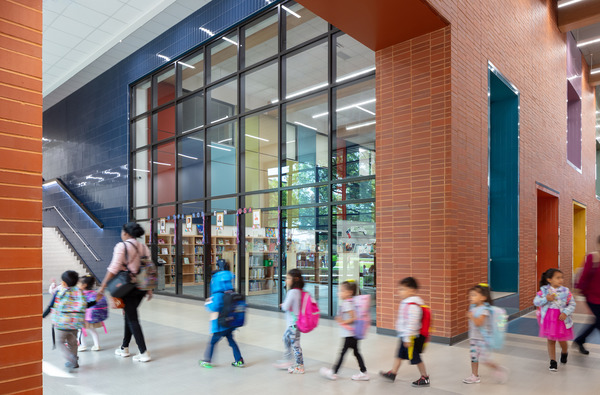
In this current climate, schools have the opportunity and responsibility to activate their campus as a powerful tool to foster educator resilience and recruit and keep top talent as empowered partners in student success. However, the severity and complexity of this pervasive challenge cannot be addressed through a singular solution, and the onus of this undertaking cannot be dealt to school districts alone. Every stakeholder needs to contribute meaningful support for our educators and students, including the design community. The integration of research-based insight and improvements to the design of education facilities can help to support educator resilience through enhanced wellbeing, fostering community and mentorship, promoting self-efficacy, and considering ergonomics.
Connecting research with design, this article with cover critical challenges in the education landscape, insights derived from research on educator resilience, direct experiential insight from real educators across the United States captured in Corgan’s national “Design Lessons from Teachers 2.0 Report”, culminating in research-informed design responses and strategies focused on supporting educators.
Understanding the Teacher Shortage
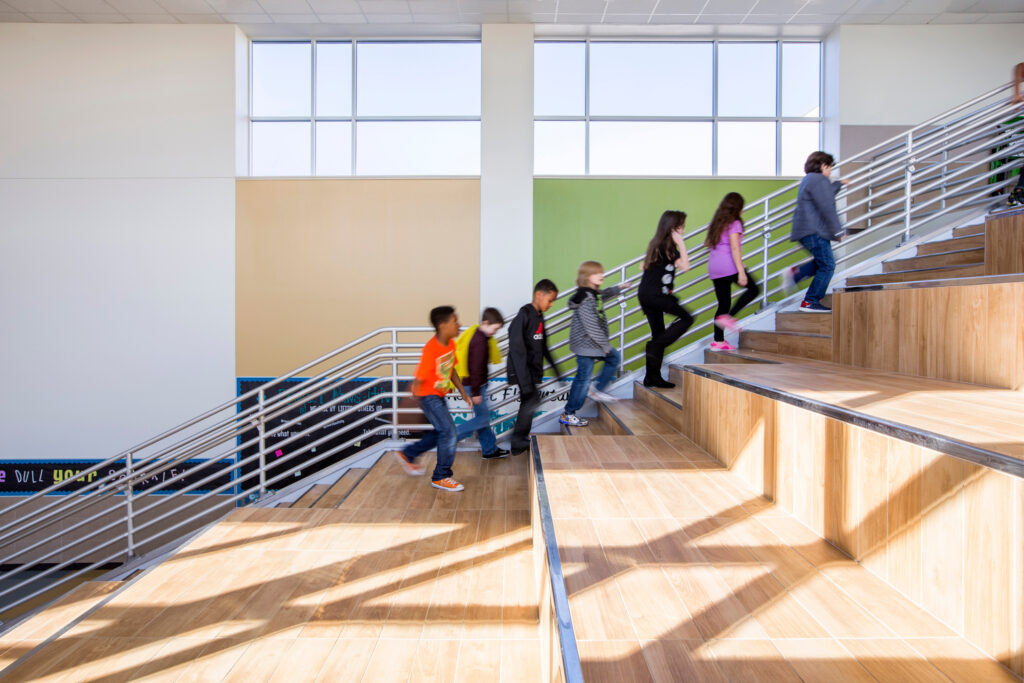
Teacher Shortages and Issues of Equity
With all 50 states reporting teacher shortages in at least one subject area in 2023, communities across the nation are struggling with teacher shortages. According to the National Center for Education Statistics, about 37% of public schools are experiencing at least one teaching vacancy (an improvement from 44% reported in 2022), and 45% are experiencing at least one non-teaching staff vacancy as of data collected in October of 2023.
While this widespread challenge with staffing shortages and teacher retention is pervasive, its impacts are not equal across school communities. Emma Garcia, Senior Researcher at the Learning Policy Institute, describes the exacerbation of existing issues of equity in education: “…shortages of well-prepared teachers have historically been most severe in schools that serve larger numbers of students from low-income families and students of color, and in subjects with greater opportunity costs, like special education, mathematics, and science.”
When examined geographically and across subject areas, widespread shortages in science, math, language arts, career technical (CTE), support staff, and more are apparent. Most notably, a concerning shortage of Special Education staff is affecting children in nearly every state. Rising enrollment in special education programs stretches special education staff and the critical support they provide thin, exacerbating burnout for teachers in these high-intensity, specialized roles and limiting access to resources for students and their families.
Why is There a Teacher Shortage?
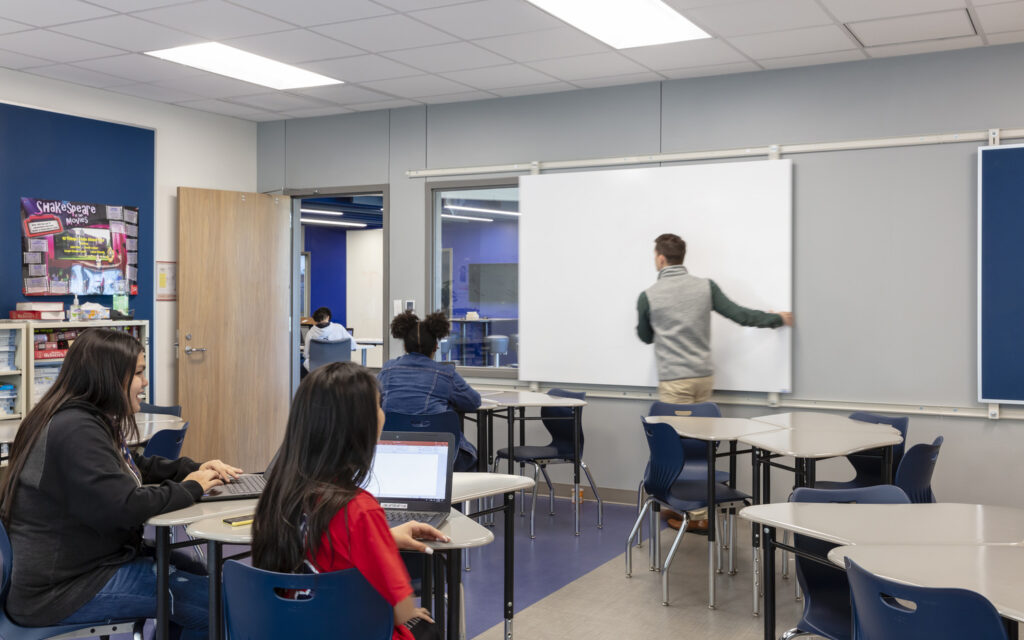
Researchers have identified four key, interrelated factors contributing to the current teacher shortage that must be understood if we are to respond effectively.
Economic Factors: Economic factors play a significant role, as increased cost of living and education outpace the rate of teacher pay, making the field of education financially unmanageable for many individuals to enter or stay in.
Decreased Enrollment in Teacher Education Programs: Reflective of these economic challenges is a significant decrease in enrollment in teacher education programs and the completion of those programs. Between 2010 to 2018, enrollment in these programs decreased by as much as a third on a national level. However, the hyperlocal nature of the education labor market means there is high geographic variability in these trends. With many educators returning to teach near their hometown, some states are seeing rising enrollment while others are seeing more significant declines.
Teachers need to be supported and inspired in order to teach. If teachers don’t feel that way, it’ll bleed over into their teaching.
Elementary School Teacher, Design Lessons from Teachers 2.0
Burnout and Low Morale: Teaching is a demanding, stressful job and burnout and low morale is pushing many teachers out of the profession. Teachers are decreasingly finding the stress and disappointments they experience in their job worthwhile, causing many to consider leaving the profession. Morale for teachers and principals significantly declined during the pandemic.
Increased Demands: Educators often wear many hats — their responsibilities extending far beyond teaching to include social and emotional guidance, family support, and more. The expectation for educators to take on accommodations for individual learning needs, recovering from pandemic learning loss, intensifying parent expectations, and the strain of additional school duties increase stress and burnout.
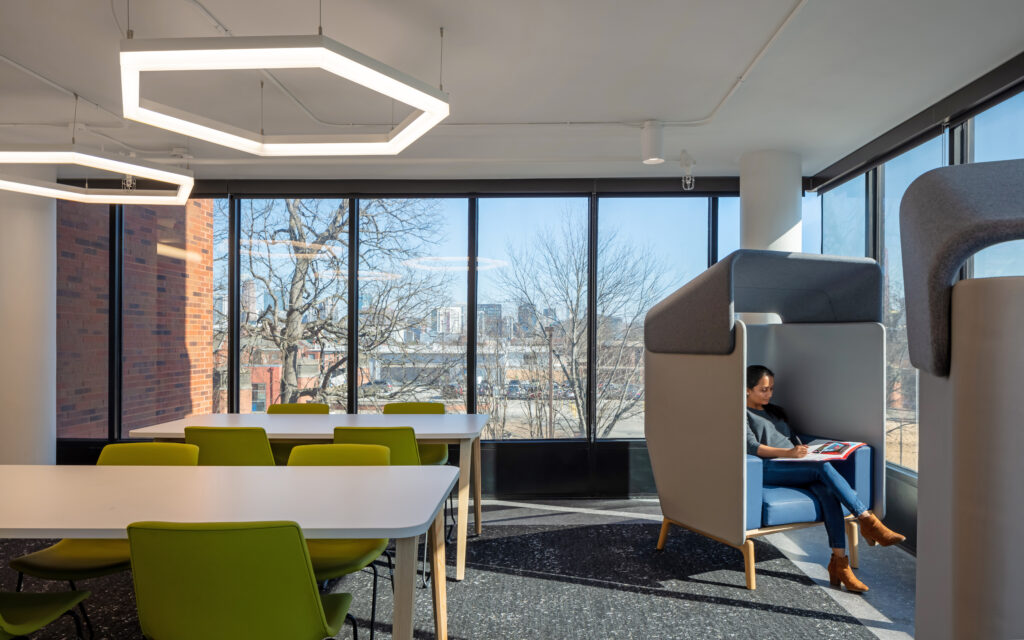
The Impact of Poor Morale, Turnover, and Educator Burnout
Poor morale and burnout often fuel teacher turnover, with a direct impact on student outcomes. Educator burnout is associated with declines in student achievement and lower quality student motivation. Teacher turnover also harms student achievement and perpetuates inequality in learning opportunities, impacts teacher effectiveness, and drains district resources for hiring and training.
Moreover, continued poor morale and high rates of burnout and teacher turnover may erode the profession’s appeal, dissuading the next generation of educators from entering the profession. In a 2022 McKinsey study, as many as 33% of teachers surveyed had plans to leave their role before the next school year, translating to about 900,000 teachers across the country with one foot out the door. Even if some of these educators ultimately chose to stay in their role, this finding is troubling for the future of the profession.
If teachers are burnt-out, exhausted, traumatized…then we can’t have a good school.
High School Teacher, Design Lessons from Teachers 2.0
Why Educators Choose to Leave the Profession, and Why They Choose to Stay
Many of the leading factors driving teachers to leave the profession- like compensation, unsustainable work expectations, and uninspiring leadership — cannot be addressed by the design community. However, other push factors like a lack of wellbeing, workplace inflexibility, and poor classroom conditions can inspire thoughtful design interventions to provide targeted support. Similarly, enhancing factors that drive educators to stay in their jobs — like community and meaningful work — should be a focus for the design of education environments.
Call to Action for Designers
Taking these contextual factors into consideration, the best way for designers to contribute to meaningful solutions in support of our nation’s educators is to listen to educators and to integrate research-based insight into our work. Drawing from both “off the shelf” research and research we conduct ourselves, we can make better informed design decisions that meet educator’s needs, enhance their working environments, and support their resilience.
Integrating Research-Based Insight
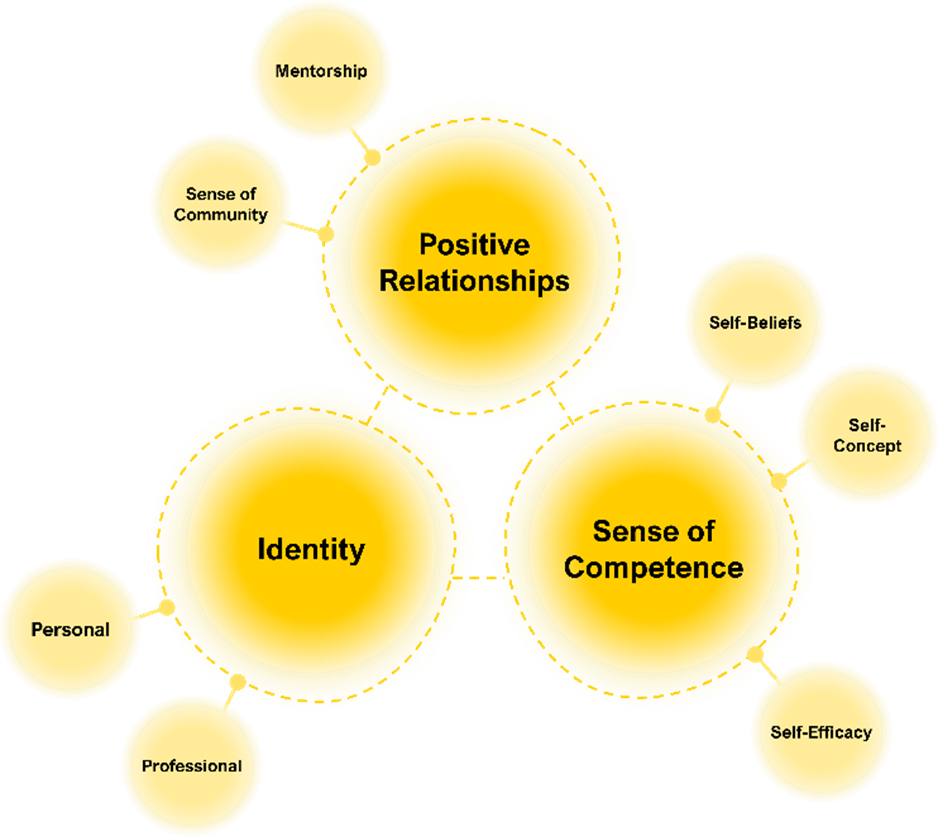
Educator Resilience
Researchers describe resilience in the teaching profession as a quality that enables teachers to overcome personal and environmental vulnerabilities and maintain their commitment to teaching in the face of work-related challenges, pressures, and demands 1, 2, 3. It is not a quality that you have or do not have, rather, resilience is a box of tools and resources (personal and contextual) an individual brings to a challenging situation to solve a problem 1, 4, 5. Resilient teachers utilize these coping strategies efficiently and effectively 1, 4.
Developing resilience is a dynamic process and requires a “whole school” approach to create a supportive system where individuals can thrive as people and professionals4. Researchers Marold Wosnitza and Francisco Piexoto assert that: “The environment can (and should) therefore provide the resources that nurture and enable the development of resilience by means of facilitating the construction of positive relationships, the construction of identity, and the development of a sense of competence.”
Notice that the researchers identified the environment and the resources it provides as a source for resilience. This perspective emphasizes the importance of a sense of community and mentorship, considerations for both personal and professional identity, and encouraging self-efficacy in the design of educators’ professional environments 4.
Corgan’s Design Lessons from Teachers 2.0 Report
Three years and one pandemic after our original 2019 “Design Lessons from Teachers” report, Corgan conducted a survey of K-12 teachers across the U.S (United States). in 2022 to better understand their needs and experiences as it pertains to the design of learning environments. After analyzing 36 in-depth interviews and 1,000 survey responses, 5 key insights were identified in “Design Lessons from Teachers 2.0”: schools as a workplace, wellbeing, physical and virtual environments, flexibility, and personalization and choice.
- Schools as a Workplace
Schools are both learning environments for students and working environments for teachers. Integrating quiet space for focused work and easy access to important resources provides professional settings where educators can attend to responsibilities outside of teaching.
Surveyed teachers are increasingly finding the design of the classroom to be important for their ability to be a good teacher, rising from 38% in 2019 to 71% in 2022 — a marked 33% difference. Currently, most teachers (77%) indicate that their desk in their classroom best supports their role responsibilities outside of teaching, making the classroom a critical space for the productivity and success of both students and educators.
One of the best things for students is for teachers to be happy and stable.
Middle School Teacher

- Wellbeing
With growing demands, heavy workloads, added responsibilities, and limited support, educators first need their “oxygen mask” before they can be there for their students, but many teachers have limited opportunities to tend to their own wellbeing. When surveyed teachers need a moment to themselves to make a personal phone call or collect themselves after a challenging situation, most go to their classroom (42%), their car in the parking lot (34%), or the bathroom (32%)- not exactly ideal locations for a recharge. Design should integrate opportunities for restoration and provide a healthy, high-quality environment that supports teachers’ overall wellness in the moments they need it most.
- Physical and Virtual Environments
Classrooms need to meet the needs of students and teachers as separate, unique users. When it comes to teaching and learning, technology is now a fundamental piece of that puzzle. Classroom design needs to seamlessly integrate and support the growing use of technology and be change-ready as technology advances in the future.
Design for student learning and a teacher workplace don’t have to be contradictory things. Right now, the environment isn’t ideal for either group.
Middle School Teacher
56% of teachers surveyed indicated that improvements in technology would help them feel more supported in their working environment. Key targets for those improvements should be the limited number of outlets, limited space for group work or collaboration, and a lack of technology or problematic technology.
- Flexibility
Expectations and standards for learning are evolving, and the classroom needs to reflect the current world, which is flexible, fluid, and dynamic. 82% of teachers surveyed reported that they would like more flexibility in their teaching environment. But what does that mean? Teachers are looking for modifiable spaces that have the appropriate affordances (technology integration, power outlets, etc.) to be reconfigured to support layouts, group sizes, and activities to align with their teaching style.

- Personalization and Choice
Teachers (and students) are under more pressure than ever to perform amidst fluctuating circumstances, and they need different tools to succeed. One of those tools is the classroom itself and the teachers’ ability to adapt their space and curriculum to meet student and personal needs. Teachers indicated that their students benefit when both students and teachers are afforded personalization and choice.
Longitudinal Findings: What Matters Most to Educators?
Examining teacher’s perceptions of the importance of various features in the learning environment reveals that teachers are most interested in the fundamentals- a safe and secure classroom, air quality, accessibility of electrical outlets, and technology-ready rooms. Features designers tend to focus on like movable walls, proximity to special features like outdoor learning spaces and breakout spaces, and variation in types of furniture fell farther down the list. This finding emphasizes the importance of meeting basic needs and aligning priorities before shifting focus to higher design aspirations.

Cultivating Educator Resilience Through Design
Connecting these findings from “Design Lessons for Teachers 2.0” to insights with teacher workforce data and research on educator resilience yields compelling opportunities for design to help cultivate educator resilience in teacher-supportive learning environments:

Opportunity for Restoration
Drawing insight and inspiration from the WELL Building Standard, the foundation of wellness-supportive professional environments for teachers should be a high-quality environment with natural light, good air quality, balanced stimulation, access to nature, comfort, and noise control to support health, wellness, and cognitive performance. Quiet spaces incorporated in shared teacher support spaces or distributed in the school can provide opportunity to decompress, turn off “teacher mode”, and focus on individual needs.

Community and Mentorship
Balance spaces provided for individual, focused work with a variety of intentional, collaborative spaces that facilitate social connection and professional mentorship. Informal touchdown spaces and small group huddle rooms can encourage educators to work together and provide mutual support. These welcoming community spaces can impart a sense of belonging, fostering a positive school climate.
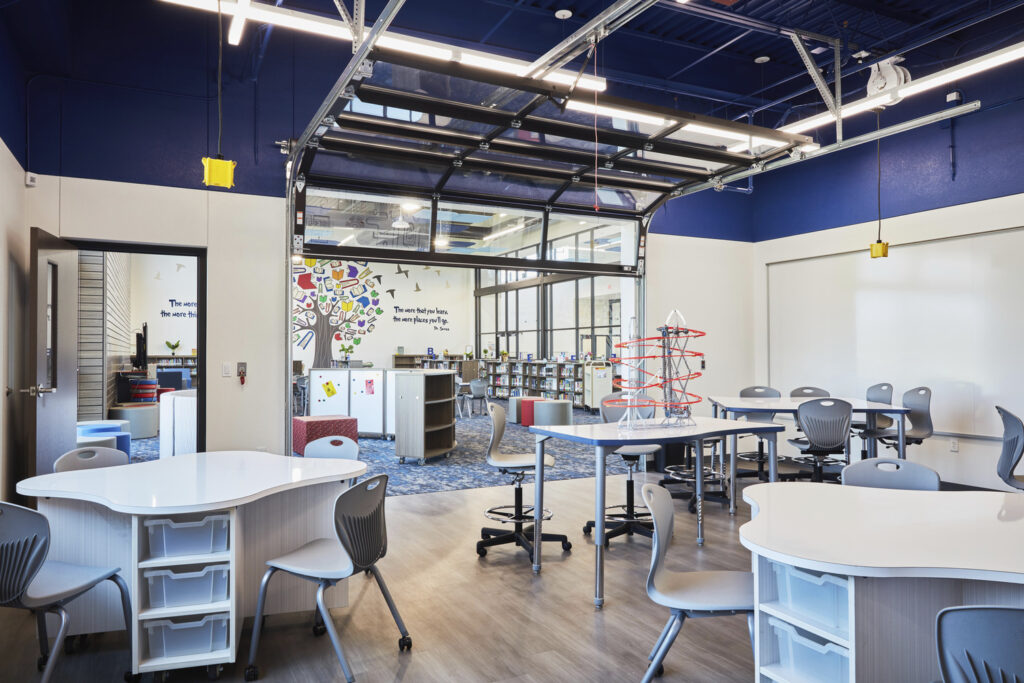
Classroom-Level Focus
When designing for educators, the focus is often placed on shared spaces like the workroom or lounge, but a common thread discovered in the Design Lessons from Teachers 2.0 report was the central importance of the classroom for supporting teachers’ wellbeing and professional needs. Integrating considerations for comfort, ergonomics, and teachers’ flow through the classroom space can help designers to strike a balance between student and teacher needs.

Self-Efficacy
Providing intuitive affordances that integrate resources and features that are easy to identify and understand with clear, readable design can help educators feel confident utilizing their space in new ways. Creating zones of activity with furniture that is easy to move and reconfigure provides open-ended opportunities to accommodate changing paradigms without overwhelm or inconvenience. Building in opportunities for educators to feel a sense of ownership at any scale provides a grounding sense of identity.
Students learn differently — whether verbal, auditory, tactile, kinesthetically…we need to meet students where they are…Teachers also have different ways they interact with students.
Middle School Teacher
Teachers play a critical role in shaping and guiding young minds into productive members of our society, but these critical contributors to our nation’s future need more support. As creators of education environments, the design community can play a part in meeting teachers’ needs, supporting their resilience and wellbeing, and fostering vibrant, supportive school communities where educators can reach their full potential. By integrating research-based insight, direct experiential insight from real educators, and our expertise as designers of learning environments, school facilities can be activated as tools for attracting and retaining great teachers and promoting both educator and student success.
Please contact the author if you would like access to the complete list of citations for this article.
Citations
- Platsidou, M., & Daniilidou, A. (2021). Meaning in life and resilience among teachers.
- Brunetti, G. J. (2006). Resilience under fire: Perspectives on the work of experienced, inner city high school teachers in the United States. Teaching and teacher education, 22(7), 812-825.
- Daniilidou, A., & Platsidou, M. (2018). Teachers’ resilience scale: An integrated instrument for assessing protective factors of teachers’ resilience. Hellenic Journal of Psychology, 15(1), 15-39.
- Wosnitza, M., & Peixoto, F. (2018). Resilience in education: Emerging trends in recent research. Resilience in education: Concepts, contexts and connections, 335-340.
- Wosnitza, M., Peixoto, F., Beltman, S., & Mansfield, C. F. (2018). Resilience in education. Dordrecht: Springer.
- Beltman, S., Mansfield, C., & Price, A. (2011). Thriving not just surviving: A review of research on teacher resilience. Educational research review, 6(3), 185-207.
- Mansfield, C. F., Beltman, S., Price, A., & McConney, A. (2012). “Don’t sweat the small stuff:” Understanding teacher resilience at the chalkface. Teaching and Teacher Education, 28(3), 357-367.

